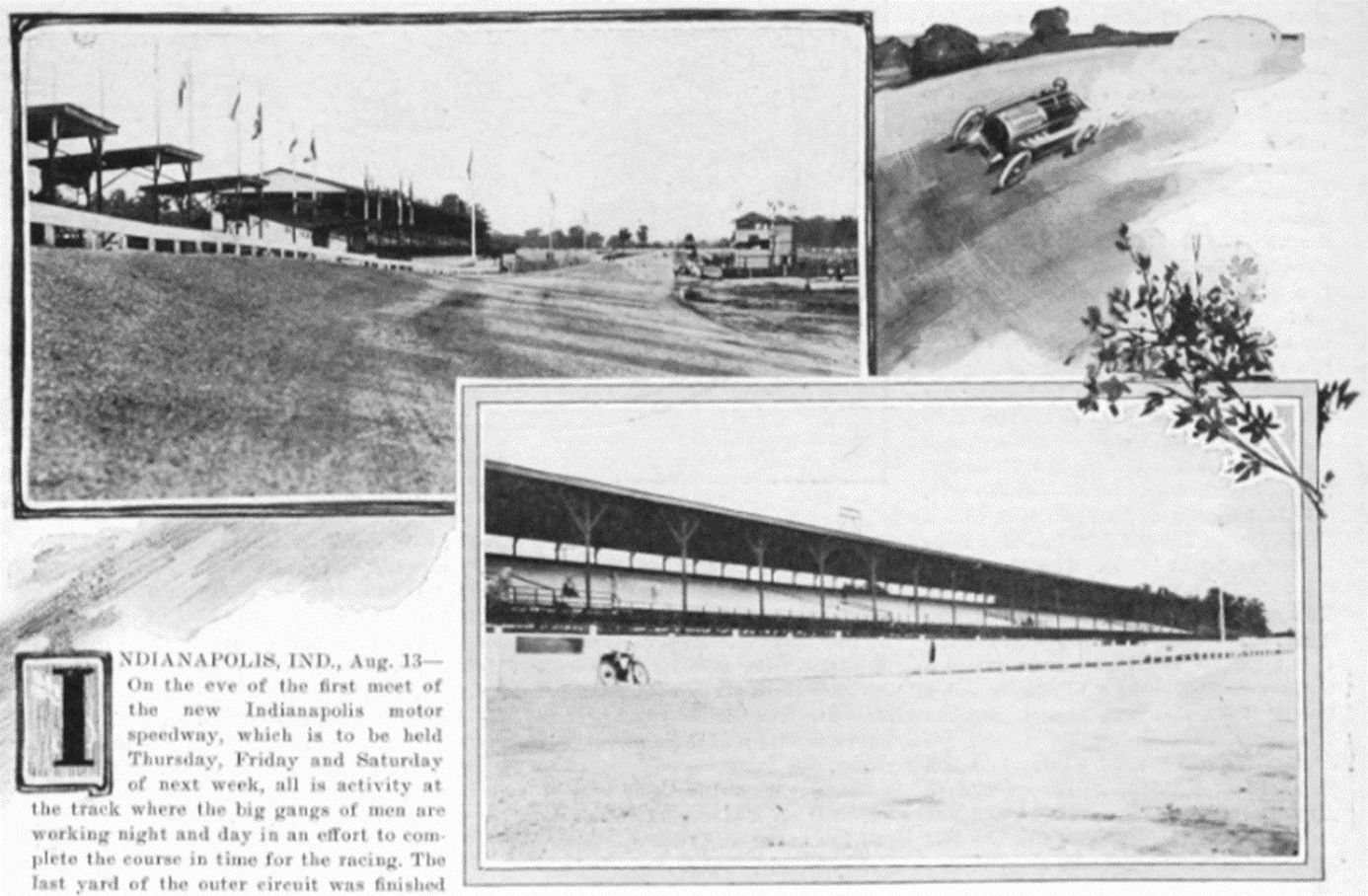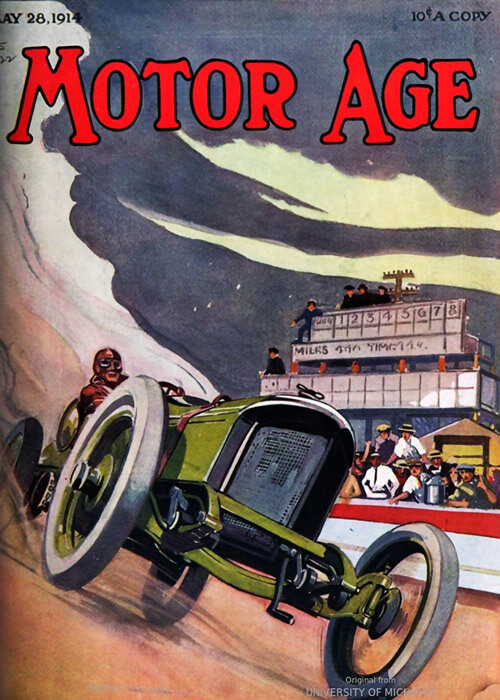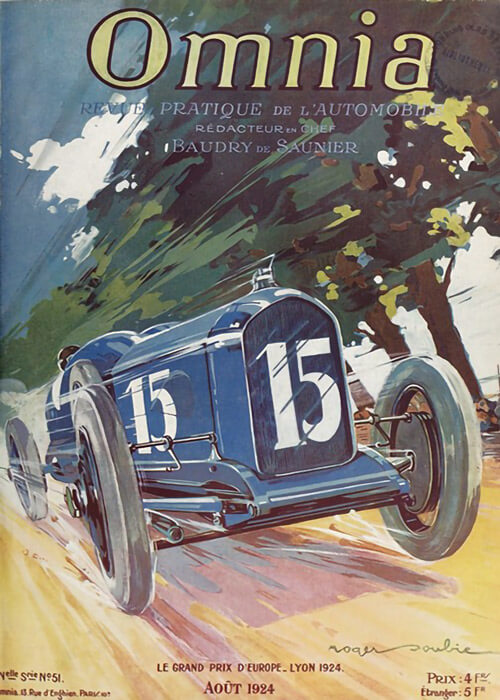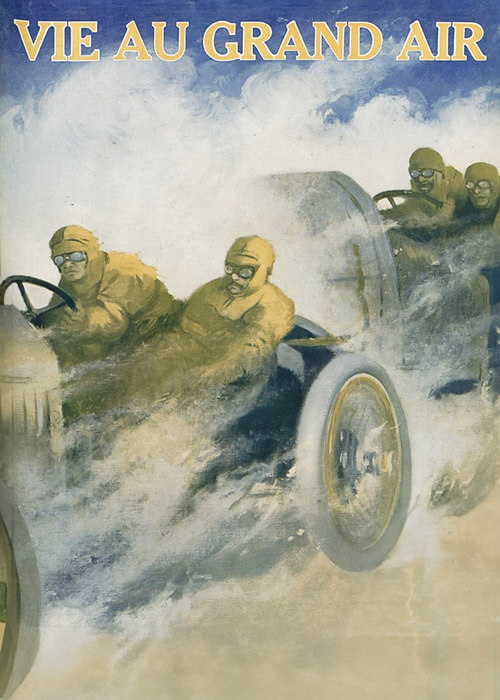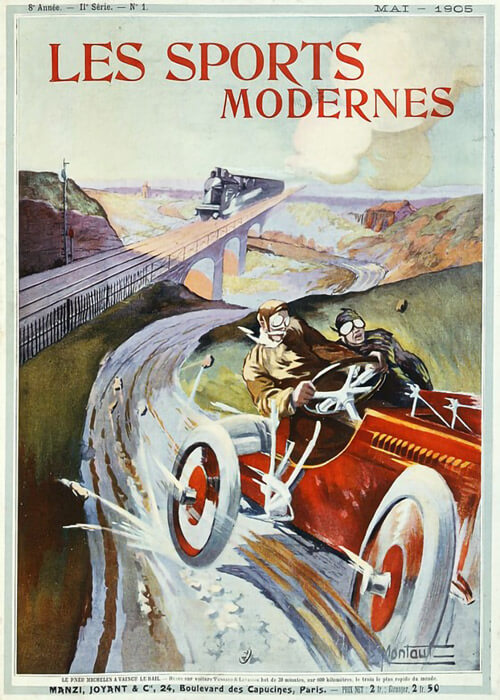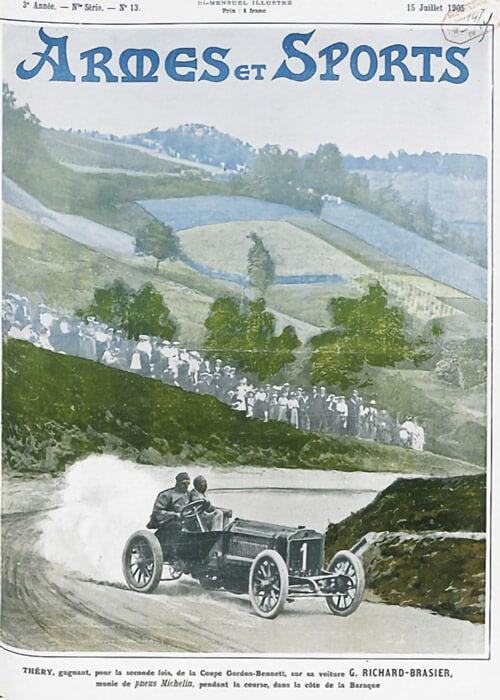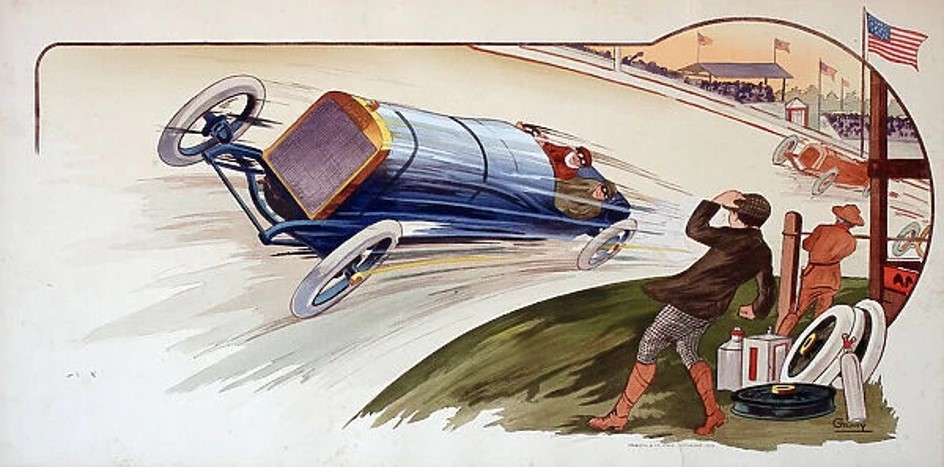It was just a week before the first-ever three racedays on the brandnew Indianapolis Motor Speedway were to beheld, that this article in Motor Age appeared. Indiacation that the entire speedway construction planning was at knife’s edge. The drwing of the track is the second design, and even that was not realised; for very good reasons though. That’s not the point! What me bothers still, is why the simple throughout final design is not shown in publications, so short before the final track.
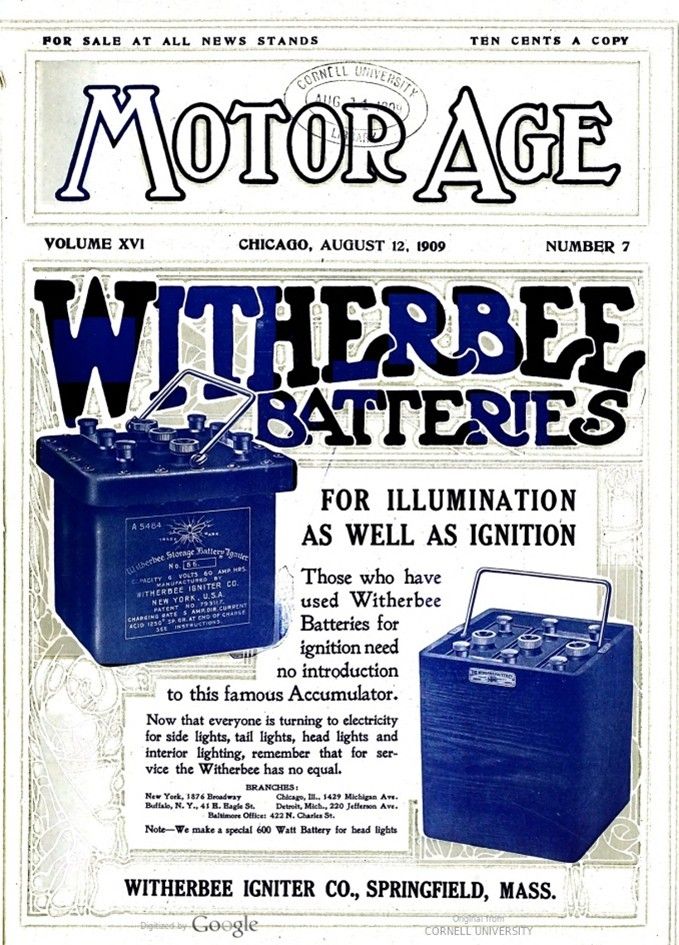
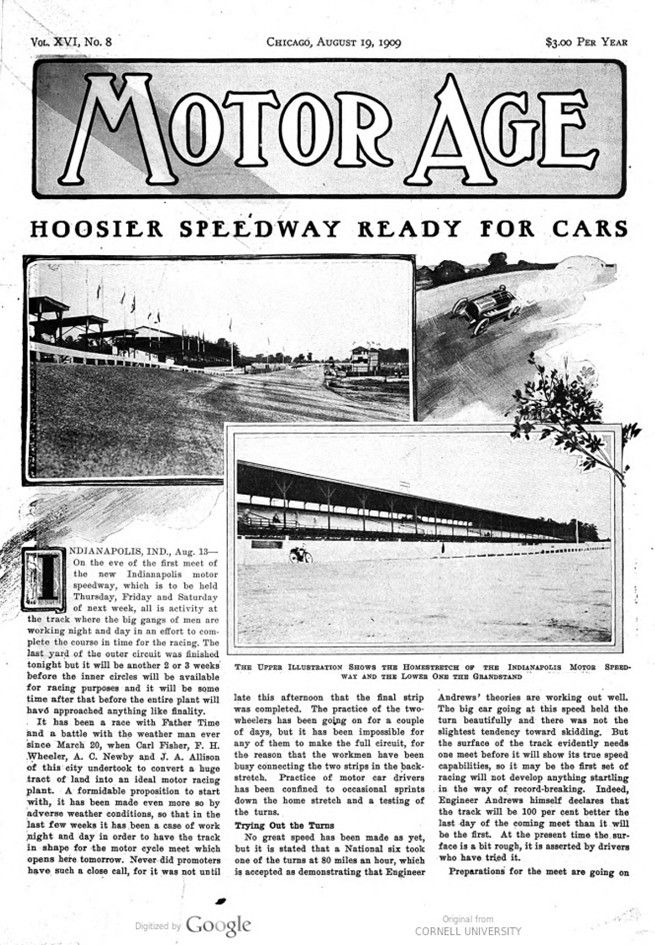
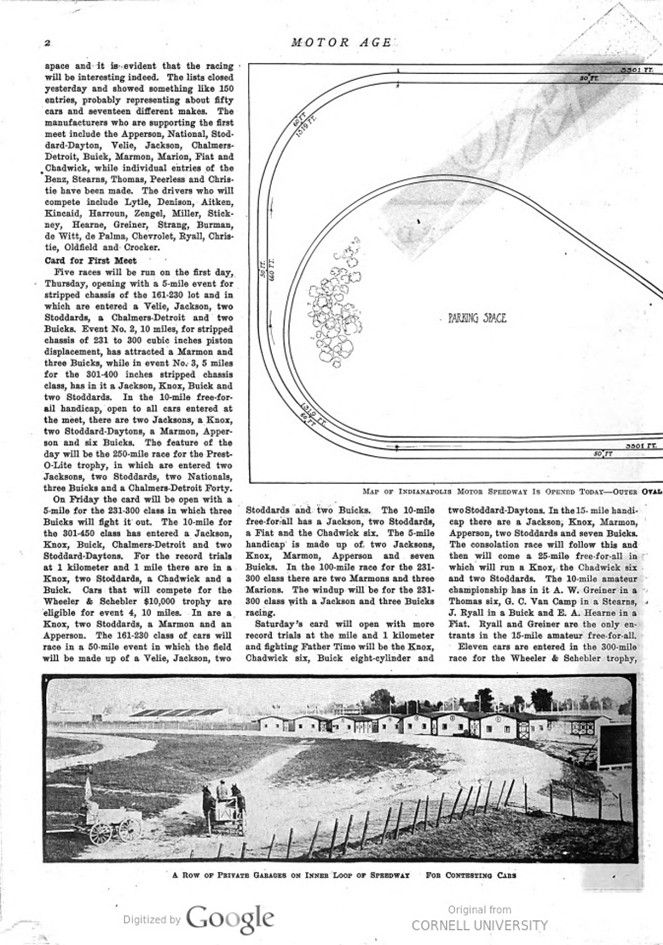
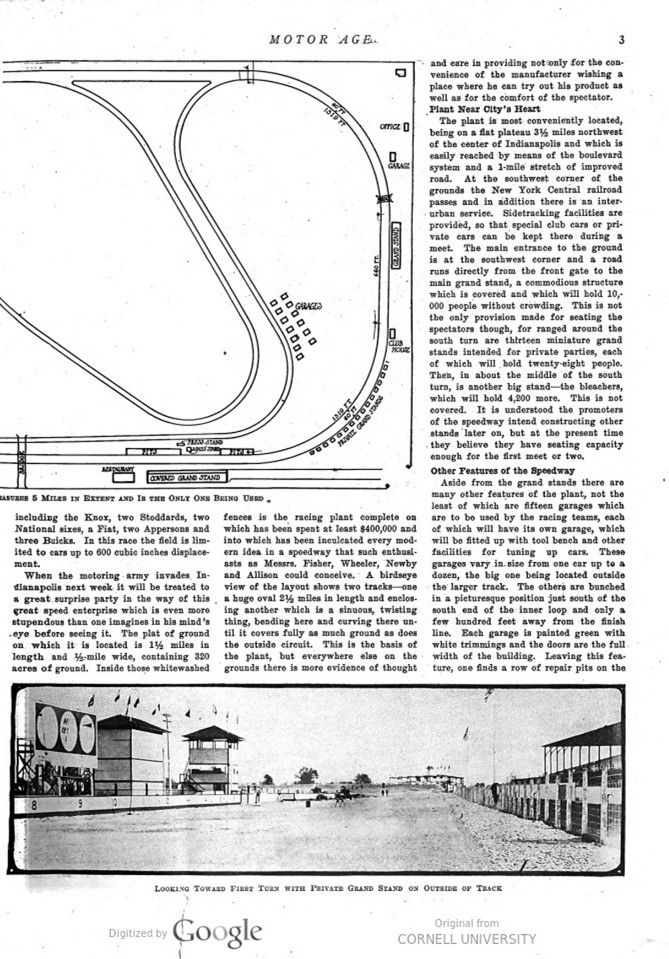
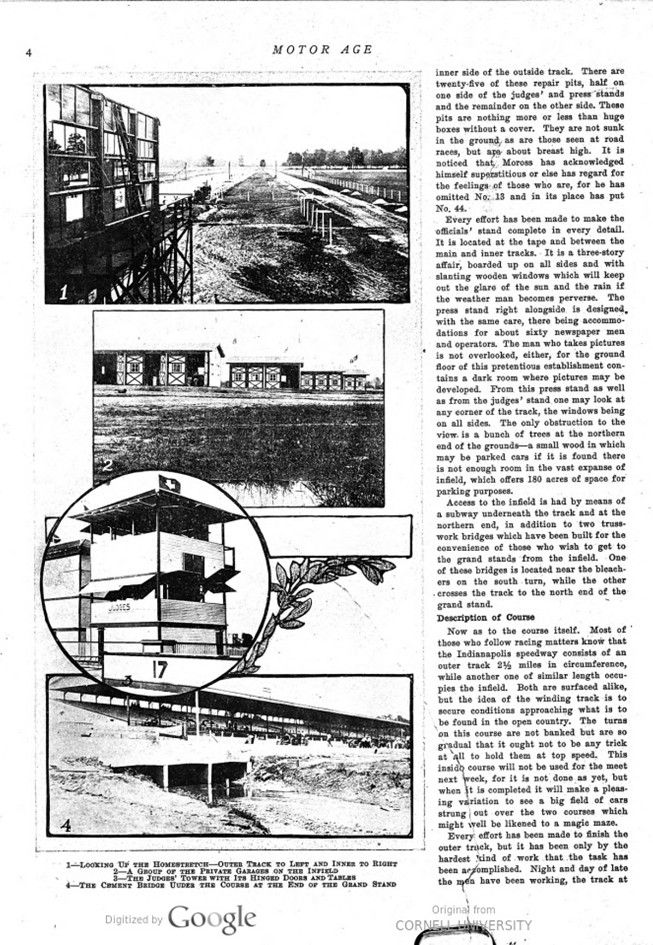
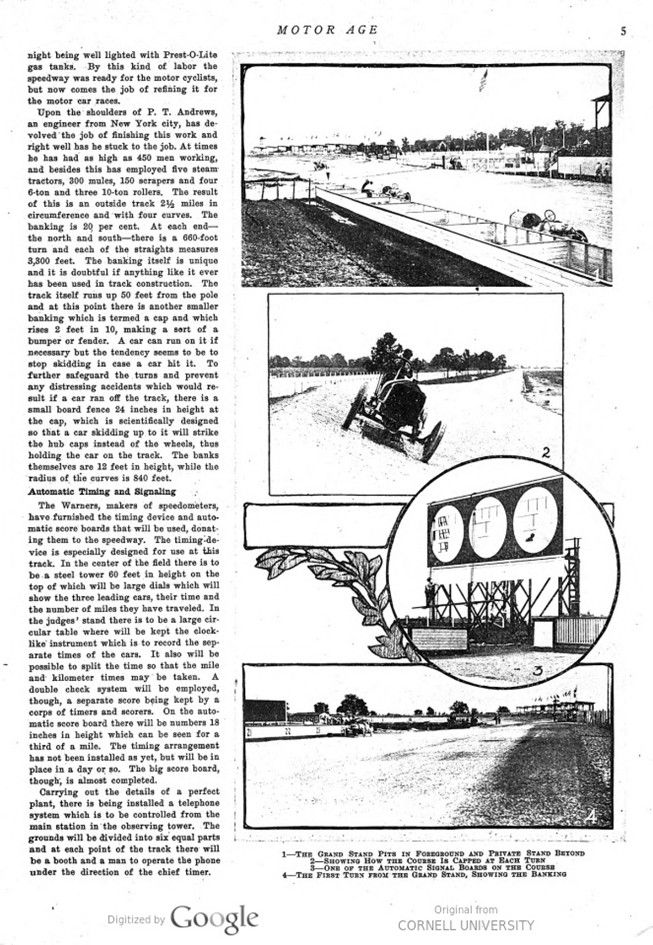
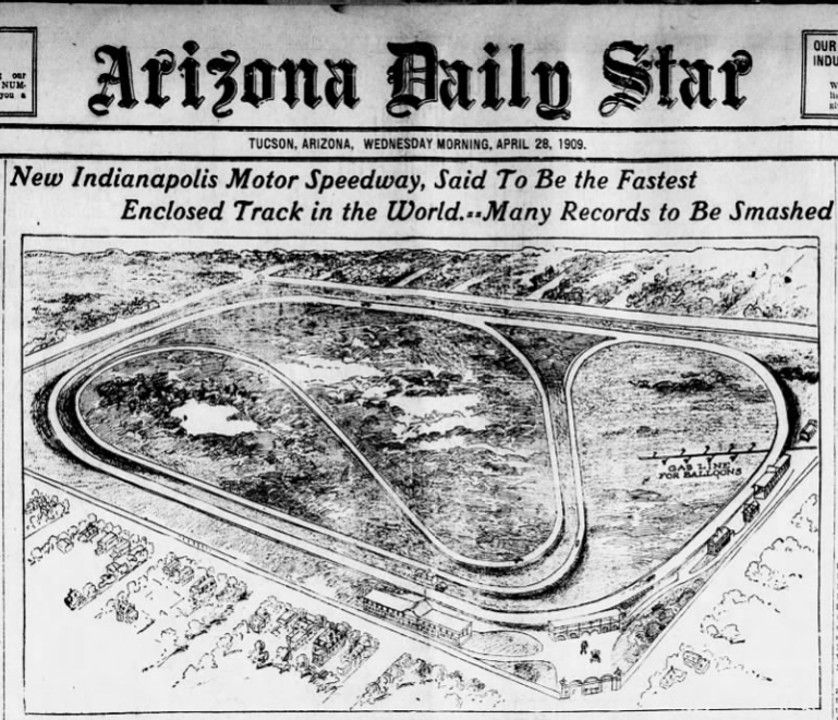
Text and jpegs by courtesy of hathitrust.org www.hathitrust.org, compiled by motorracinghistory.com
Motor Age Volume XVI, No. 8, August 19, 1909.
HOOSIER SPEEDWAY READY FOR CARS
INDIANAPOLIS, IND., Aug. 13 – On the eve of the first meet of the new Indianapolis motor speedway, which is to be held Thursday, Friday and Saturday of next week, all is activity at the track where the big gangs of men are working night and day in an effort to complete the course in time for the racing. The last yard of the outer circuit was finished tonight but it will be another 2 or 3 weeks before the inner circles will be available for racing purposes and it will be some time after that before the entire plant will have approached anything like finality.
It has been a race with Father Time and a battle with the weather man ever since March 20, when Carl Fisher, F. H. Wheeler, A. C. Newby and J. A. Allison of this city undertook to convert a huge tract of land into an ideal motor racing plant. A formidable proposition to start with, it has been made even more so by adverse weather conditions, so that in the last few weeks it has been a case of work night and day in order to have the track in shape for the motor cycle meet which opens here tomorrow. Never did promoters have such a close call, for it was not until late this afternoon that the final strip was completed. The practice of the two- wheelers has been going on for a couple of days, but it has been impossible for any of them to make the full circuit, for the reason that the workmen have been busy connecting the two strips in the backstretch. Practice of motor car drivers has been confined to occasional sprints down the home stretch and a testing of the turns.
Trying Out the Turns
No great speed has been made as yet, but it is stated that a National six took one of the turns at 80 miles an hour, which is accepted as demonstrating that Engineer Andrews‘ theories are working out well. The big car going at this speed held the turn beautifully and there was not the slightest tendency toward skidding. But the surface of the track evidently needs one meet before it will show its true speed capabilities, so it may be the first set of racing will not develop anything startling in the way of record-breaking. Indeed, Engineer Andrews himself declares that the track will be 100 per cent better the last day of the coming meet than it will be the first. At the present time the sur- face is a bit rough, it is asserted by drivers who have tried it. Preparations for the meet are going on apace and it is evident that the racing will be interesting indeed. The lists closed yesterday and showed something like 150 entries, probably representing about fifty cars and seventeen different makes. The manufacturers who are supporting the first meet include the Apperson, National, Stoddard-Dayton, Velie, Jackson, Chalmers- Detroit, Buick, Marmon, Marion, Fiat and Chadwick, while individual entries of the Benz, Stearns, Thomas, Peerless and Chris- tie have been made. The drivers who will compete include Lytle, Denison, Aitken, Kincaid, Harroun, Zengel, Miller, Stickney, Hearne, Greiner, Strang, Burman, de Witt, de Palma, Chevrolet, Ryall, Christie, Oldfield and Crocker.
Card for First Meet
Five races will be run on the first day, Thursday, opening with a 5-mile event for stripped chassis of the 161-230 lot and in which are entered a Velie, Jackson, two Stoddards, a Chalmers-Detroit and two Buicks. Event No. 2, 10 miles, for stripped chassis of 231 to 300 cubic inches piston displacement, has attracted a Marmon and three Buicks, while in event No. 3, 5 miles for the 301-400 inches stripped chassis class, has in it a Jackson, Knox, Buick and two Stoddards. In the 10-mile free-for-all handicap, open to all cars entered at the meet, there are two Jacksons, a Knox, two Stoddard-Daytons, a Marmon, Apperson and six Buicks. The feature of the day will be the 250-mile race for the Prest-O-Lite trophy, in which are entered two Jacksons, two Stoddards, two Nationals, three Buicks and a Chalmers-Detroit Forty.
On Friday the card will be open with a 5-mile for the 231-300 class in which three Buicks will fight it out. The 10-mile for the 301-450 class has entered a Jackson, Knox, Buick, Chalmers-Detroit and two Stoddard-Daytons. For the record trials at 1 kilometer and 1 mile there are in a Knox, two Stoddards, a Chadwick and a Buick. Cars that will compete for the Wheeler & Schebler $10,000 trophy are eligible for event 4, 10 miles. In are a Knox, two Stoddards, a Marmon and an Apperson. The 161-230 class of cars will race in a 50-mile event in which the field will be made up of a Velie, Jackson, two Stoddards and two Buicks. The 10-mile free-for-all has a Jackson, two Stoddards, a Fiat and the Chadwick six. The 5-mile handicap is made up of two Jacksons, Knox, Marmon, Apperson and seven Buicks. In the 100-mile race for the 231-300 class there are two Marmons and three Marions. The windup will be for the 231-300 class with a Jackson and three Buicks racing.
Saturday’s card will open with more record trials at the mile and 1 kilometer and fighting Father Time will be the Knox, Chadwick six, Buick eight-cylinder and two Stoddard-Daytons. In the 15-mile handicap there are a Jackson, Knox, Marmon, Apperson, two Stoddards and seven Buicks. The consolation race will follow this and then will come a 25-mile free-for-all in which will run a Knox, the Chadwick six and two Stoddards. The 10-mile amateur championship has in it A. W. Greiner in a Thomas six, G. C. Van Camp in a Stearns, J. Ryall in a Buick and E. A. Hearne in a Fiat. Ryall and Greiner are the only entrants in the 15-mile amateur free-for-all.
Eleven cars are entered in the 300-mile race for the Wheeler & Schebler trophy, including the Knox, two Stoddards, two National sixes, a Fiat, two Appersons and three Buicks. In this race the field is limited to cars up to 600 cubic inches displacement.
When the motoring army invades Indianapolis next week it will be treated to a great surprise party in the way of this great speed enterprise which is even more stupendous than one imagines in his mind’s eye before seeing it. The plat of ground on which it is located is 1% miles in length and 14-mile wide, containing 320 acres of ground. Inside those whitewashed fences is the racing plant complete on which has been spent at least $400,000 and into which has been inculcated every modern idea in a speedway that such enthusiasts as Messrs. Fisher, Wheeler, Newby and Allison could conceive. A birdseye view of the layout shows two tracks — one a huge oval 2% miles in length and enclosing another which is a sinuous, twisting thing, bending here and curving there until it covers fully as much ground as does the outside circuit. This is the basis of the plant, but everywhere else on the grounds there is more evidence of thought and care in providing not only for the convenience of the manufacturer wishing a place where he can try out his product as well as for the comfort of the spectator.
Plant Near City’s Heart
The plant is most conveniently located, being on a flat plateau 3% miles northwest of the center of Indianapolis and which is easily reached by means of the boulevard system and a 1-mile stretch of improved road. At the southwest corner of the grounds the New York Central railroad passes and in addition there is an interurban service. Sidetracking facilities are provided, so that special club cars or private cars can be kept there during a meet. The main entrance to the ground is at the southwest corner and a road runs directly from the front gate to the main grand stand, a commodious structure which is covered and which will hold 10,000 people without crowding. This is not the only provision made for seating the spectators though, for ranged around the south turn are thirteen miniature grand stands intended for private parties, each of which will hold twenty-eight people. Then, in about the middle of the south turn, is another big stand — the bleachers, which will hold 4,200 more. This is not covered. It is understood the promoters of the speedway intend constructing other stands later on, but at the present time they believe they have seating capacity enough for the first meet or two.
Other Features of the Speedway
Aside from the grand stands there are many other features of the plant, not the least of which are fifteen garages which are to be used by the racing teams, each of which will have its own garage, which will be fitted up with tool bench and other facilities for tuning up cars. These garages vary in size from one car up to a dozen, the big one being located outside the larger track. The others are bunched in a picturesque position just south of the south end of the inner loop and only a few hundred feet away from the finish line. Each garage is painted green with white trimmings and the doors are the full width of the building. Leaving this feature, one finds a row of repair pits on the inner side of the outside track. There are twenty-five of these repair pits, half on one side of the judges‘ and press stands and the remainder on the other side. These pits are nothing more or less than huge boxes without a cover. They are not sunk in the ground as are those seen at road races, but are about breast high. It is noticed that Moross has acknowledged himself superstitious or else has regard for the feelings of those who are, for he has omitted No. 13 and in its place has put No. 44.
Every effort has been made to make the officials’ stand complete in every detail. It is located at the tape and between the main and inner tracks. It is a three-story affair, boarded up on all sides and with slanting wooden windows which will keep out the glare of the sun and the rain if the weather man becomes perverse. The press stand right alongside is designed with the same care, there being accommodations for about sixty newspaper men and operators. The man who takes pictures is not overlooked, either, for the ground floor of this pretentious establishment contains a dark room where pictures may be developed. From this press stand as well as from the judges‘ stand one may look at any corner of the track, the windows being on all sides. The only obstruction to the view is a bunch of trees at the northern end of the grounds — a small wood in which may be parked cars if it is found there is not enough room in the vast expanse of infield, which offers 180 acres of space for parking purposes.
Access to the infield is had by means of a subway underneath the track and at the northern end, in addition to two trusswork bridges which have been built for the convenience of those who wish to get to the grand stands from the infield. One of these bridges is located near the bleachers [~ tribunes zonder overkapping] on the south turn, while the other crosses the track to the north end of the grand stand.
Description of Course
Now as to the course itself. Most of those who follow racing matters know that the Indianapolis speedway consists of an outer track 2% miles in circumference, while another one of similar length occupies the infield. Both are surfaced alike, but the idea of the winding track is to secure conditions approaching what is to be found in the open country. The turns on this course are not banked but are so gradual that it ought not to be any trick at all to hold them at top speed. This inside course will not be used for the meet next week, for it is not done as yet, but when it is completed it will make a pleasing variation to see a big field of cars strung out over the two courses which might well be likened to a magic maze.
Every effort has been made to finish the outer track, but it has been only by the hardest kind of work that the task has been accomplished. Night and day of late the men have been working, the track at night being well lighted with Prest-O-Lite gas tanks. By this kind of labor the speedway was ready for the motor cyclists, but now comes the job of refining it for the motor car races.
Upon the shoulders of P. T. Andrews, an engineer from New York city, has devolved the job of finishing this work and right well has he stuck to the job. At times he has had as high as 450 men working, and besides this has employed five steam tractors, 300 mules, 150 scrapers and four 6-ton and three 10-ton rollers. The result of this is an outside track 2½ miles in circumference and with four curves. The banking is 20 per cent. At each end – the north and south — there is a 660-foot turn and each of the straights measures 3,300 feet. The banking itself is unique and it is doubtful if anything like it ever has been used in track construction. The track itself runs up 50 feet from the pole and at this point there is another smaller banking which is termed a cap and which rises 2 feet in 10, making a sort of a bumper or fender. A car can run on it if necessary but the tendency seems to be to stop skidding in case a car hit it. To further safeguard the turns and prevent any distressing accidents which would result if a car ran off the track, there is a small board fence 24 inches in height at the cap, which is scientifically designed so that a car skidding up to it will strike the hub caps instead of the wheels, thus holding the car on the track. The banks themselves are 12 feet in height, while the radius of the curves is 840 feet.
Automatic Timing and Signaling
The Warners, makers of speedometers, have furnished the timing device and automatic score boards that will be used, donating them to the speedway. The timing device is especially designed for use at this track. In the center of the field there is to be a steel tower 60 feet in height on the top of which will be large dials which will show the three leading cars, their time and the number of miles they have traveled. In the judges‘ stand there is to be a large circular table where will be kept the clock- like instrument which is to record the separate times of the cars. It also will be possible to split the time so that the mile and kilometer times may be taken. A double check system will be employed, though, a separate score being kept by a corps of timers and scorers. On the automatic score board there will be numbers 18 inches in height which can be seen for a third of a mile. The timing arrangement has not been installed as yet, but will be in place in a day or so. The big score board, though, is almost completed.
Carrying out the details of a perfect plant, there is being installed a telephone system which is to be controlled from the main station in the observing tower. The grounds will be divided into six equal parts and at each point of the track there will be a booth and a man to operate the phone under the direction of the chief timer.
Photo captions.
Page 1. – The Upper Illustration Shows the Homestretch of the Indianapolis Motor Speedway and the Lower One the Grandstand
Page 2. – Map of Indianapolis Motor Speedway is Opened Today – Outer Oval Measures 5 Miles in Extent and Is the Only One Being Used – A Row of Private Garages on Inner Loop of Speedway For Contesting Cars
Page 3. – Looking Toward First Turn With Private Grand Stand on Outside Track
Page 4.
1 – Looking Up The Homestretch Outer Track to Left and Inner to Right
2 – A Group of the Private Garages on the Infield
3 – The Judges‘ Tower, with its Hinged Doors and Tables
4 – The Cement Bridge under the Course at the End of the Grand Stand
Page 5.
1 – The Grand Stand Pits in Foreground and Private Stand Beyond
2 – Showing How The Course Is Capped at Each Turn
3 – 0ne of the Automatic Signal Boards on the Course
4 – The Firs Turn From The Grand Stand, Showing The Banking
